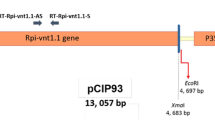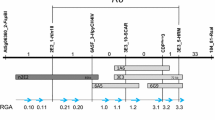Abstract
Bacterial spot disease of tomato and pepper caused by Xanthomonas campestris pv vesicatoria is prevented by resistance genes in the plant that match genes for avirulence in the bacterium. Based on DNA homology to the avirulence gene avrBs3, which induces the resistance response on pepper, we have isolated another avirulence gene from X. c. vesicatoria, designated avrBs3-2. This gene differs in specificity from avrBs3 in inducing the hypersensitive response on tomato but not on pepper. Sequence analysis of the avrBs3-2 gene revealed a high degree of conservation: the 3480 by open reading frame contains an internal region of 17.5 nearly identical 102 bp repeat units that differ in their order from those present in the avrBs3 gene. The coding region is 97% identical to avrBs3 and expresses constitutively a 122 kDa protein, thus representing a natural allele of this gene. The previously isolated 1.7 kb avrBsP gene from X. c. vesicatoria is 100% identical to the corresponding avrBs3-2 sequence, indicating that these genes might be identical. Interestingly, derivatives of avrBs3-2 lacking the C-terminal region and part of the repetitive region are still able to confer incompatibility in tomato. The avrBs3-2 gene is compared with the sequence of avrBs3 derivatives generated by deletion of repeat units that also have avirulence activity on tomato. Both genes, avrBs3 and avrBs3-2, are flanked by a 62 by long inverted repeat, which prompts speculations about the origin of the members of the avrBs3 gene family.
Similar content being viewed by others
References
Bonas U, Stall RE, Staskawicz B (1989) Genetic and structural characterization of the avirulence gene avrBs3 from Xanthomonas campestris pv. vesicatoria. Mol Gen Genet 218:127–136
Canteros B, Minsavage G, Bonas U, Pring D, Stall R (1991) A gene from Xanthomonas campestris pv. vesicatoria that determines avirulence in tomato is related to avrBs3. Mol Plant-Microbe Interact 4:628–632
Daniels MJ, Leach JE (1992) Genetics of Xanthomonas. In: Swings J, Civerolo EL (eds) Xanthomonas. (in press)
Daniels MJ, Barber CE, Turner PC, Sawczyc MK, Byrde RJW, Fielding AH (1984) Cloning of genes involved in pathogenicity of Xanthomonas campestris pv. campestris using the broad host range cosmid pLAFR1. EMBO J 3:3323–3328
De Feyter R, Gabriel DW (1991) At least six avirulence genes are clustered on a 90-kilobase plasmid in Xanthomonas campestris pv. malvacearum. Mol Plant-Microbe Interact 4:423–432
Devereux J, Haeberli P, Smithson O (1984) A comprehensive set of sequence analysis programmes for the VAX. Nucleic Acids Res 12:387–395
Ditta G, Stanfield S, Corbin D, Helinski D (1980) Broad host range DNA cloning system for gram-negative bacteria: Construction of a gene bank of Rhizobium meliloti. Proc Natl Acad Sci USA 77:7347–7351
Fenselau S, Balbo I, Bonas U (1992) Determinants of pathogenicity in Xanthomonas campestris pv. vesicatoria are related to proteins involved in secretion in bacterial pathogens of animals. Mol Plant-Microbe Interact 5:390–396
Figurski D, Helinski DR (1979) Replication of an origin-containing derivative of plasmid RK2 dependent on a plasmid function provided in trans. Proc Natl Acad Sci USA 76:1648–1652
Herbers K, Conrads-Strauch J, Bonas U (1992) Race-specificity of plant resistance to bacterial spot disease determined by repetitive motifs in a bacterial avirulence protein. Nature 356:172–174
Keen NT (1990) Gene-for-gene complementarity in plant-pathogen interactions. Annu Rev Genet 24:447–463
Keen NT (1992) The molecular biology of disease resistance. Plant Mol Biol 19:109–122
Keen NT, Tamaki S, Kobayashi D, Gerhold D, Stayton M, Shen H, Gold S, Lorang J, Thordal-Christensen H, Dahlbeck D, Staskawicz B (1990) Bacteria expressing avirulence gene D produce a specific elicitor of the soybean hypersensitive reaction. Mol Plant-Microbe Interact 3:112–121
Klement Z (1982) Hypersensitivity. In: Mount MS, Lacy GH (eds) Phytopathogenic prokaryotes, vol 2. Academic Press, New York, pp 149–177
Knoop V, Staskawicz BJ, Bonas U (1991) The expression of the avirulence gene avrBs3 from Xanthomonas campestris pv. vesicatoria is not under the control of hrp genes and is independent of plant factors. J Bacteriol 173:7142–7150
Kobayashi DY, Tamaki SJ, Trollinger DJ, Gold S, Keen NT (1990) A gene from Pseudomonas syringae pv. glycinea with homology to avirulence gene D from P. s. pv. tomato but devoid of the avirulence phenotype. Mol Plant-Microbe Interact 3:103–111
Maniatis T, Fritsch EF, Sambrook J (1982) Molecular cloning: A laboratory manual. Cold Spring Harbor Laboratory Press, Cold Spring Harbor, New York
Miller JH (1972) Experiments in Molecular Genetics. Cold Spring Harbor Laboratory Press, Cold Spring Harbor, New York
Minsavage GV, Dahlbeck D, Whalen MC, Kearney B, Bonas U, Staskawicz BJ, Stall RE (1990) Gene-for-gene relationships specifying disease resistance in Xanthomonas campestris pv. vesicatoria-pepper interactions. Mol Plant-Microbe Interact 3:41–47
Sanger F, Nicklen S, Coulson AR (1977) DNA sequencing with chain-terminating inhibitors. Proc Natl Acad Sci USA 74:5463–5467
Staskawicz BJ, Dahlbeck D, Keen NT (1984) Cloned avirulence gene of Pseudomonas syringae pv. glycinea determines race-specific incompatibility on Glycine max (L.) Merr. Proc Natl Acad Sci USA 81:6024–6028
Staskawicz BJ, Dahlbeck D, Keen N, Napoli C (1987) Molecular characterization of cloned avirulence genes from race 0 and race 1 of Pseudomonas syringae pv. glycinea. J Bacteriol 169:5789–5794
Swarup S, De Feyter R, Brlansky RH, Gabriel DW (1991) A pathogenicity locus from Xanthomonas citri enables strains from several pathovars of X. campestris to elicit cankerlike lesions on citrus. Phytopathology 81:802–809
Swarup S, Yang Y, Kingsley MT, Gabriel DW (1992) A Xanthomonas citri pathogenicity gene, pthA, pleiotropically encodes gratuitous avirulence on nonhosts. Mol Plant-Microbe Interact 5:204–213
Tamaki S, Dahlbeck D, Staskawicz B, Keen NT (1988) Characterization and expression of two avirulence genes cloned from Pseudomonas syringae pv. glycinea. J Bacteriol 170:4846–4854
Tamaki S, Kobayashi DY, Keen NT (1991) Sequence domains required for the activity of avirulence genes avrB and avrC from Pseudomonas syringae pv. glycinea. J Bacteriol 170:301–307
Author information
Authors and Affiliations
Additional information
Communicated by H. Hennecke
Rights and permissions
About this article
Cite this article
Bonas, U., Conrads-Strauch, J. & Balbo, I. Resistance in tomato to Xanthomonas campestris pv vesicatoria is determined by alleles of the pepper-specific avirulence gene avrBs3 . Molec. Gen. Genet. 238, 261–269 (1993). https://doi.org/10.1007/BF00279555
Received:
Accepted:
Issue Date:
DOI: https://doi.org/10.1007/BF00279555




